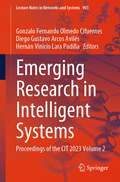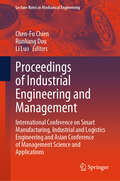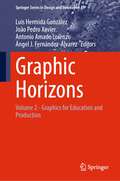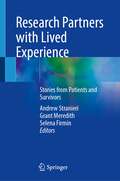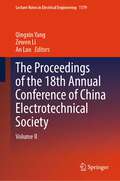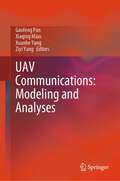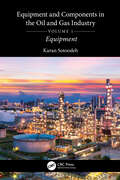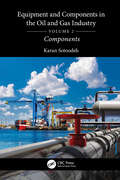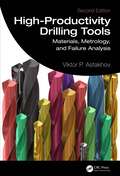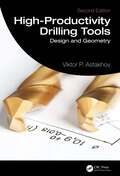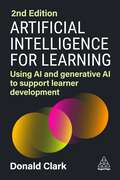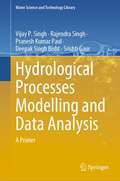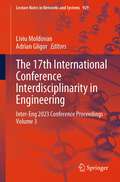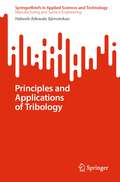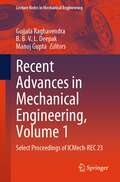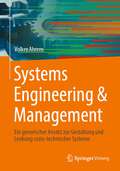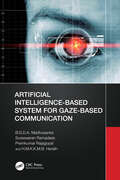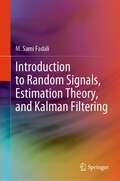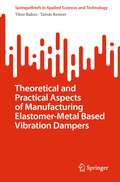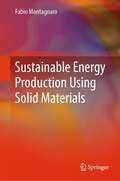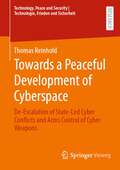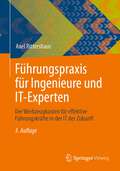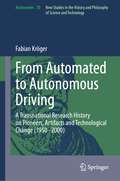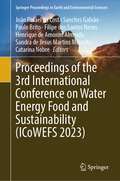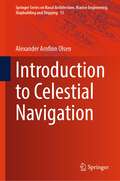- Table View
- List View
Emerging Research in Intelligent Systems: Proceedings of the CIT 2023 Volume 2 (Lecture Notes in Networks and Systems #903)
by Gonzalo Fernando Olmedo Cifuentes Diego Gustavo Arcos Avilés Hernán Vinicio Lara PadillaThis book covers different aspects of advances in research, technological development, and innovation results in artificial intelligence, computational modeling, electrical, electronics, telecommunication, data communications, defense engineering, innovation, technology and society, managing technology and sustained innovation, business development, security and cryptography, and software engineering. In addition, the volume focuses on research results focused on finding innovative solutions in intelligent systems concerning the topics mentioned above, which are developed in national and international postgraduate programs and associated research groups and networks. This book interests the industry, teachers, undergraduate and graduate students, and researchers working in intelligent systems, security and defense, and technological, human, and administrative sciences.
Proceedings of Industrial Engineering and Management: International Conference on Smart Manufacturing, Industrial and Logistics Engineering and Asian Conference of Management Science and Applications (Lecture Notes in Mechanical Engineering)
by Chen-Fu Chien Runliang Dou Li LuoThis book is a compilation of selected papers from the 3rd International Conference on Smart Manufacturing, Industrial & Logistics Engineering (SMILE2023) and the 7th Asian Conference of Management Science and Applications (ACMSA2023). The book focuses on the recent theoretical and methodological developments, significant technical applications, case studies, and survey results in the areas of manufacturing informatics, manufacturing intelligence, big data analytics and data mining, modeling and decision analysis, Internet of Things, green supply chains, and intelligent logistics. The book makes valuable contributions to academic researchers and engineers in smart manufacturing, industrial engineering, and logistics, as well as readers will encounter new ideas to promote Digital Intelligence Transformation.
Graphic Horizons: Volume 2 - Graphics for Education and Production (Springer Series in Design and Innovation #43)
by Luis Hermida González João Pedro Xavier Antonio Amado Lorenzo Ángel J. Fernández-ÁlvarezThis book reports on several advances in architectural graphics, with a special emphasis on education, training, and architectural production. It gathers a selection of contributions to the 20th International Congress of Architectural Graphic Expression, EGA 2024, held on May 27-29, 2024, in Porto, Portugal, with the motto: "Graphic Horizons". This is the second of a 3-volume set.
Research Partners with Lived Experience: Stories from Patients and Survivors
by Andrew Stranieri Grant Meredith Selena FirminThis book aims to foster collaborations between patients who have intense lived experience with a medical condition or family violence and researchers investigating them. Inviting patients or survivors into the research team is found to have significant advantages, and chapters review the literature on the benefits they can bring to investigative research teams. The collaboration can take place at multiple stages of research from helping to research design, participating in co-investigators, contributing to the interpretation of results, etc. The conditions addressed in this book include medical conditions from anxiety, postural orthostatic tachycardia syndrome, lupus, asthma, chronic kidney disease, etc. The authors are higher degree students, academics, and active research team members who share their experiences. This is be instrumental in helping patients and survivors decide whether to transition to research. It will also support research team leaders in determining how to benefit from the new perspectives researchers with lived experience bring. The personal narratives provide insight into the challenges and rewards of having lived experience while conducting research. This book is a valuable resource for researchers in clinical fields who have been touched by firsthand exposure to a condition and have been motivated to conduct research in the respective fields. The chapters will enrich understanding for adult patients and survivors and for parents of children suffering intense experiences, who engage with the latest research publications. It will also broaden the understanding of medical, biomedical, and health sciences students interested in reading the narrative accounts of patients and survivors. Readers will gain refreshing perspectives and insights. The book relates to patients managing all kinds of noncommunicable diseases or experiences of violence, and how they can share their valuable experiences into future advancementto research. It is related to SDG 3, good health and well-being.
The Proceedings of the 18th Annual Conference of China Electrotechnical Society: Volume II (Lecture Notes in Electrical Engineering #1179)
by Qingxin Yang Zewen Li An LuoThis book gathers outstanding papers presented at the 18th Annual Conference of China Electrotechnical Society, organized by China Electrotechnical Society (CES), held in Nanchang, China, from September 15 to 17, 2023. It covers topics such as electrical technology, power systems, electromagnetic emission technology, and electrical equipment. It introduces the innovative solutions that combine ideas from multiple disciplines. The book is very much helpful and useful for the researchers, engineers, practitioners, research students, and interested readers.
UAV Communications: Modeling and Analyses
by Gaofeng Pan Xiaqing Miao Xuanhe Yang Ziyi YangThis book provides a comprehensive treatment of the performance evaluation of UAV communication systems, using stochastic geometry to explore the impact of the random positions of UAVs on transmission performance. The book focuses on engineering practice, with both modeling and analysis of UAV communication systems. It offers an in-depth study of several important UAV communication application scenarios, including UAV-terrestrial communication, UAV-to-UAV communication, satellite-UAV communication, and UAV relay communication.One of the key features of the book is its systematic approach to addressing UAV communication issues and providing practical insights. The book is especially useful for readers interested in learning how to model and analyze the performance of UAV communications systems. It will benefit researchers, engineers, and graduate students in the fields of wireless communications, signal processing, and related areas.
Equipment and Components in the Oil and Gas Industry Volume 1: Equipment
by Karan SotoodehEquipment and Components in the Oil and Gas Industry Volume 1: Equipment provides an overview of the equipment used in the oil and gas industry, as well as various stages of the oil and gas industry, including geology, exploration, drilling, transportation, and refining. Using practical industry examples and an accessible approach, the book is a key reference point for those seeking to learn more about the industry.The equipment used in the oil and gas industry is wide ranging, from drilling equipment and wellhead equipment, such as casings, tubing, and wellhead Christmas trees, to equipment for the transportation of fluids and gases, such as pumps and compressors. The book presents a simplified method to choose the correct equipment for each task, as well as covering the selection of heat exchangers and storage tanks. Finally, this book covers turbines, motors, and other prime movers, alongside a flare system for disposing of unwanted or waste gases in oil and gas refineries and petrochemical plants.This book will be of interest to mechanical and chemical engineers working in the oil and gas industry.
Equipment and Components in the Oil and Gas Industry Volume 2: Components
by Karan SotoodehEquipment and Components in the Oil and Gas Industry Volume 2: Components provides an overview of the components used in the oil and gas industry, including instrumentation, pipe components, and safety components. Using practical industry examples and an accessible approach, the book is a key reference point for those seeking to learn more about the industry.Covering both larger and smaller components used throughout the oil and gas industry, the book details the theory behind pressure gauges, temperature gauges, flow gauges, and level gauges. It then goes on to discuss piping components, such as pipes, flanges, and gaskets and introduces piping special components. Valves are particularly crucial to the oil and gas industry, including on/off valves, control valves, safety valves, and special valves. The book also details actuators, sprinklers, fire and gas detectors, hoses, and hose reels, along with electrical components such as switches, cables, wires, and cable glands. Finally, the book ends with a discussion of heating, ventilation, and air conditioning (HVAC) components.This book will be of interest to mechanical and chemical engineers working in the oil and gas industry.
High-Productivity Drilling Tools: Materials, Metrology, and Failure Analysis
by Viktor P. AstakhovThis completely updated volume covers tool materials, tolerances, an inspection of drilling tools, requirements of tool drawings with examples, and methodologies and procedures of failure analysis. It introduces a new line of HP drilling tools called VPA designs and brings it into sharp focus signifying its importance in drilling operations.High-Productivity Drilling Tools: Materials, Metrology, and Failure Analysis further develops the concept of the metrology of the drilling tools introduced in the first edition. For the first time, the relevant metrological parameters are clearly defined with tolerance for HPHD with practical examples of step-by-step inspection/measurement using advanced tool measurement microscopes and CNC machines. A pros and cons list as a quick and easy decision-making tool for the choice of measuring equipment for a particular application is offered along with practical examples of drilling tool drawings to help tool designers, cutting tool and manufacturing engineers, and users in their everyday activities in the design and selection of HPDT for a particular application. An unparalleled presentation of metalworking fluids (MWFs, a.k.a. coolants) is given and covers all the start of the business: selection, implementation in HPDT and drilling operation, monitoring, and maintenance. A two-step procedure for successful implementation of near-dry machining (NDM) or minimum quantity lubrication (MQL) is presented, and a discussion of the wear of the drilling tool, its proper assessments, and metrics are provided in the evaluation of tool life and quality of machined holes.This practical book should be on the shelves of all industrial engineers, those working in production and manufacturing, process designers, tool material designers, cutting tool designers, and quality specialists. Researchers, senior undergraduate students, and graduate students will also find this book full of very helpful reference information and the source of new ideas and notions in drilling tool development.
High-Productivity Drilling Tools: Design and Geometry
by Viktor P. AstakhovThis completely updated volume covers the design, manufacturing, and inspection of high‑productivity drilling tools (HPDT) and addresses common issues with drilling system components. It discards old notions and beliefs as it introduces scientifically and technically sound concepts and rules with detailed explanations and multiple practical examples.High‑Productivity Drilling Tools: Design and Geometry introduces the development of the concept of high‑productivity (HP) drill design and its manufacturing and application features. This book continues to develop the concept of a drilling system in the new edition and includes new practical examples. It explains how to properly design and manufacture drilling tools for a specific application and includes a detailed explanation of the design features, tool manufacturing and implementation practices, metrology of drilling and drilling tools, and the tool failure analysis. Using the coherency law as the guidelines introduced in the first edition, the new edition shows how to formulate the requirements for the components of the drilling system, pointing out that the drilling tool is the key component to be improved.This practical book should be on the shelves of all industrial engineers, those working in production and manufacturing, process designers, tool material designers, cutting tool designers, and quality specialists. Researchers, senior undergraduate students, and graduate students will also find this book full of very helpful reference information.
Artificial Intelligence for Learning: Using AI and Generative AI to Support Learner Development
by Donald ClarkWith Artificial Intelligence (AI) creating huge opportunities for learning and employee development, how can learning professionals best implement the use of AI into their environment?Artificial Intelligence for Learning is the essential guide for learning professionals who want to understand how to use AI to improve all aspects of learning in organizations. This new edition debunks the myths and misconceptions around AI, discusses the learning theory behind generative AI and gives strategic and practical advice on how AI can be used.This book also includes specific guidance on how AI can provide learning support, chatbot functionality and content, as well as ideas on ethics and personalization. This book is necessary reading for all learning practitioners needing to understand AI and what it means in practice.
Hydrological Processes Modelling and Data Analysis: A Primer (Water Science and Technology Library #127)
by Vijay P. Singh Rajendra Singh Pranesh Kumar Paul Deepak Singh Bisht Srishti GaurThis book provides a state-of-the-art overview of the concepts and methodologies of data and modelling-driven hydrological analyses and their wide range of practical applications. The book is driven by the realisation that science, technology, engineering, and mathematics (STEM) concepts are essential in engineering hydrology to produce well-trained hydrologists. Such hydrologists will be equipped to face future societal challenges that require enhanced information and communication technology tools and integration of technical and non-technical areas. The book contains 12 chapters that introduce the principles of hydrological data analysis and highlight the current and emerging tools and techniques for analysing hydrologic data. The book describes the types of data typically used in hydrological analyses. It highlights the revolutionary technological advancements made toward hydrological data collection, including the use of drones and smartphones. The foremost objective of the book is to present the hydrological data analysis procedures. It explains the steps involved in data analysis for easy understanding of the reader, including students and professionals. This book presents case studies that demonstrate step-by-step procedures involved in typical analysis problems and may guide students and professionals in planning and executing steps to analyse the problem at hand. Case study examples will guide them to understand the intricacies of hydrological data analysis. It provides the readers with a complete package to enrich their understanding of the hydrological data analysis tools and techniques. Subsequently, as well-trained hydrologists, they could execute their learning to meet any specific grand challenge of the twenty-first century.
The 17th International Conference Interdisciplinarity in Engineering: Inter-Eng 2023 Conference Proceedings - Volume 3 (Lecture Notes in Networks and Systems #929)
by Liviu Moldovan Adrian GligorThis book contains research papers that were accepted for presentation at the 17th International Conference on Interdisciplinarity in Engineering—INTER-ENG 2023, which was held on 5–6 October 2023, in the city of Târgu Mureș, Romania. The general scope of the conference “Towards transition for a more competitive European industry in a smart, safe and sustainable future” is proposing a new approach related to the development of a new generation of smart factories grounded on the manufacturing and assembly process digitalization. It is related to advance manufacturing technology, lean manufacturing, sustainable manufacturing, additive manufacturing, manufacturing tools and equipment. It is a leading international professional and scientific forum of great interest for engineers and scientists who can read in this book research works contributions and recent developments as well as current practices in advanced fields of engineering.
Principles and Applications of Tribology (SpringerBriefs in Applied Sciences and Technology)
by Habeeb Adewale AjimotokanThis book presents a comprehensive exploration of tribology concepts and their real-world implications, delving into introductory principles as well as advanced topics such as friction, lubrication, and wear. Tailored for engineers across diverse disciplines, it serves as a fundamental resource for both undergraduate engineering courses and postgraduate studies focused on tribology. Moreover, it caters to the needs of mechanical, materials, and biomechanics researchers, engineers, academics, and industry professionals alike. Noteworthy features include unique engineering perspectives, practical discussions on lubrication principles for minimizing friction and wear, and guidance on selecting optimal lubricants and materials for various tribological applications.
Recent Advances in Mechanical Engineering, Volume 1: Select Proceedings of ICMech-REC 23 (Lecture Notes in Mechanical Engineering)
by Gujjala Raghavendra B. B. V. L. Deepak Manoj GuptaThis book presents select proceedings of International Conference on Mechanical Engineering: Researches and Evolutionary Challenges (ICMech-REC 23). It covers the latest research in the areas of mechanical engineering and materials applications. Various topics covered in this book are materials (composite, nano-, advanced), design methodologies, Industry 4.0, smart manufacturing, thermodynamics, mechatronics, robotics, soft computing, and automation. The contents of this book are useful to the researchers and professionals working in the different areas of mechanical engineering.
Systems Engineering & Management: Ein generischer Ansatz zur Gestaltung und Lenkung sozio-technischer Systeme
by Volker AhrensDieses Buch zeigt Schritt für Schritt, wie man technische Systeme effizient und effektiv entwickelt, realisiert (Engineering) und betreibt (Administration). Dazu wird zunächst erklärt, wie komplexe reale Systeme vereinfacht, also modelliert werden, um ihre relevanten Eigenschaften sichtbar zu machen. Dies erfolgt interdisziplinär, indem neben technologischen auch soziologische und psychologische Aspekte berücksichtigt werden. Anschließend werden fünf allgemeingültige Vorgehensmodelle erläutert, die ausreichen, um Systeme in allen ihren Lebensphasen zu gestalten und zu lenken. Schließlich wird der Problemlösungszyklus im Detail erläutert. Für jede Phase einer Entwicklung wird erklärt, was wann, warum und wie getan werden sollte, um das Vorhaben erfolgreich abzuschließen. Ergänzend werden Bezüge zum Projektmanagement hergestellt. Alle erläuterten Modelle, Methoden, Verfahren und Werkzeuge haben sich in der Praxis schon vielfach bewährt. Daher eignet sich das Buch als Leitfaden für Praktiker*innen und für die akademische Lehre. Vor allem diejenigen, die nicht nur wissen wollen, was sie tun sollen, sondern auch verstehen wollen, warum das eine besser funktioniert als das andere, werden nicht nur entsprechende Erklärungen finden, sondern darüber hinaus auch zahlreiche Anregungen, die zum konstruktiv-kritischen Weiterdenken verleiten und Innovation ermöglichen.
Artificial Intelligence-Based System for Gaze-Based Communication
by B.G.D.A. Madhusanka Sureswaran Ramadass Premkumar Rajagopal H.M.K.K.M.B. HerathThis book focuses on the artificial neural network-based system for gaze-based communication. It covers the feasible and practical collaboration of human–computer interaction (HCI) in which a user can intuitively express tasks using gaze-based communication. It will target the vast applications of gaze-based communication using computer vision, image processing, and artificial intelligence.Artificial Intelligence-Based System for Gaze-Based Communication introduces a novel method to recognize the implicit intention of users by using nonverbal communication in combination with computer vision technologies. A novel HCI framework is developed to enable implicit and intuitive gaze-based intention communications. This framework allows the users to intuitively express their intention using natural gaze cues. The book also focuses on robot caregiving technology, which can understand the user’s intentions using minimal interactions with the user. The authors examine gaze-based tracking applications for the assisted living of elderly people. The book examines detailed applications of eye-gaze communication for real-life problems. It also examines the advantages that most people can handle gaze-based communications because it requires very little effort, and most of the elderly and impaired can retain visual capability.This book is ideally designed for students, researchers, academicians, and professionals interested in exploring and implementing gaze-based communication strategies and those working in the field of computer vision and image processing.
Introduction to Random Signals, Estimation Theory, and Kalman Filtering
by M. Sami FadaliThis book provides first-year graduate engineering students and practicing engineers with a solid introduction to random signals and estimation. It includes a statistical background that is often omitted in other textbooks but is essential for a clear understanding of estimators and their properties. The book emphasizes applicability rather than mathematical theory. It includes many examples and exercises to demonstrate and learn the theory that makes extensive use of MATLAB and its toolboxes. Although there are several excellent books on random signals and Kalman filtering, this book fulfills the need for a book that is suitable for a single-semester course that covers both random signals and Kalman filters and is used for a two-semester course for students that need remedial background. For students interested in more advanced studies in the area, the book provides a bridge between typical undergraduate engineering education and more advanced graduate-level courses.
Theoretical and Practical Aspects of Manufacturing Elastomer-Metal Based Vibration Dampers (SpringerBriefs in Applied Sciences and Technology)
by Tibor Babos Tamás RennerThis book offers a comprehensive breakdown of rubber industry procedures, serving as an invaluable resource for enhancing professional literacy. It covers measurable technological parameters, manufacturing processes, and metallurgy of the materials required for producing high-value rubber-metal machine components. These components find wide applications in the engineering industry, including buffers, vibration damping elements, pipe expansion joints, and silent blocks (vibration dampers vulcanized between steel pipes). The manufacturing of modern machine components necessitates meeting high technical standards and ensuring flawless performance throughout their lifetime. This goal is accomplished by manufacturing components to the required technical parameters with consistent quality specified during the design stage. Unfortunately, scientific descriptions of rubber-metal bonding technologies often lack the detail required for practical application. This book addresses this gap by presenting extensive research conducted by Renner Rubber Products, a key player in the rubber market in Central Europe, drawing on practical experience from the Centre for Security Studies at the Hungarian University of Agriculture and Life Sciences. The book provides a set of technological specifications for rubber-metal bonding based on experiments, measurements, calculations, and proven research results. A noteworthy aspect of the book is that it is the result of close scientific collaboration between academia and industry-leading players, resulting in a highly qualified product applicable in science, academia, and industrial production alike. It serves as a valuable tool for anyone in the engineering industry seeking to enhance their understanding of rubber industry procedures and produce high-quality rubber-metal machine components.
Sustainable Energy Production Using Solid Materials
by Fabio MontagnaroThis textbook focuses on sustainable energy production using solid materials. With explanatory tables and figures, case studies, worked-out examples, and up-to-date bibliographies of other works, the book provides an in-depth exploration of the most innovative aspects of the field.Readers of the book will gain critical skills in characterizing and reacting to biomass, including the formation of pollutants, as well as using fluidized bed reactors for heterogeneous processes. The book also explores innovative methods for mitigating the greenhouse effect, reusing ashes as adsorbents or in cement production, and thermochemical solar energy storage. This book will give students, novice researchers, and industry professionals valuable insights and knowledge into the sustainable production of energy using solid materials.
Towards a Peaceful Development of Cyberspace: De-Escalation of State-Led Cyber Conflicts and Arms Control of Cyber Weapons (Technology, Peace and Security I Technologie, Frieden und Sicherheit)
by Thomas ReinholdThe cyberspace and its global infrastructures are essential for our civilizations, the economy and administration. However, cyberspace is also increasingly developing into an intelligence and military operational area, visible in the creation of military cyber departments and the integration of cyberspace into states' security and defense strategies. Unfortunately, many of the established toolset of transparency, de-escalation and arms control measures do not work for cyberspace due to its specific technical characteristics. But how de-escalation of state-led conflicts in cyberspace can be achieved and how arms control of cyber weapons can be developed? Based on a technical perspective with regard to the underlying political challenges, the book follows an approach of adopting already existing technical measures from other fields of the computer science. It presents a classification system for cyberweapons, an approach for the mutual reduction of vulnerability stockpiles and provides an approach to prove the non-involvement in a cyber conflict. Beyond this, it aims to provide some impulses regarding the responsibility and creative options of the computer science with a view to the peaceful development and use of cyberspace.
Führungspraxis für Ingenieure und IT-Experten: Der Werkzeugkasten für effektive Führungskräfte in der IT der Zukunft
by Axel RittershausDas Buch geht auf die konkreten Probleme der Führung in der IT ein, räumt mit überholten Standardlehren auf und konzentriert sich auf die Fähigkeiten der IT-Führungskraft der Zukunft. Der Leser erhält sofort umsetzbare Handlungsempfehlungen, die durch Fallbeispiele auf Basis von Interviews mit IT-Führungskräften internationaler Unternehmen ergänzt werden.Wenn Sie es als IT-Führungskraft satt haben, dass die IT als Kostenfaktor statt als Business Enabler gesehen wird, wenn Sie überzeugt sind, dass die IT der Zukunft eine ganz andere Arbeits- und Führungsweise erfordert, wenn Ihre IT nicht mehr als Handlanger zur sinnbefreiten Kennzahlen-Generierung missbraucht, sondern als innovativer Partner des Business akzeptiert werden soll, dann ist dieses Buch genau das Richtige. Wollen Sie jedoch weitermachen wie bislang, ist es nichts für Sie.
From Automated to Autonomous Driving: A Transnational Research History on Pioneers, Artifacts and Technological Change (1950-2000) (Archimedes #70)
by Fabian KrögerThis book presents the most important milestones of the research on automated and autonomous driving in the United States, Japan and Europe throughout five decades (1950-2000). Drawing on sources from the automotive industry, electrical engineering, the robotics and AI-domain and military institutions, it retraces the transition from the guidance-cable approach to vehicle-based sensor and vision systems. Giving a detailed overview of the technical concepts, artefacts, research vehicles and robots, the book presents the transnational engineering efforts that started long before Silicon Valley entered the field. In addition, the book also uniquely details the role of the military in the domain of vehicle automation. This all ensures the book is of great interest to historians of technology, practitioners in engineering disciplines, scholars working in mobility studies, journalists, and political decision makers.
Proceedings of the 3rd International Conference on Water Energy Food and Sustainability (Springer Proceedings in Earth and Environmental Sciences)
by João Rafael da Costa Sanches Galvão Paulo Brito Filipe dos Santos Neves Henrique de Amorim Almeida Sandra de Jesus Martins Mourato Catarina NobreThis book presents some of the work presented at the 3rd International Conference on Water Energy Food and Sustainability—ICoWEFS 2023, with topics delving into critical global themes. Encompassing four pivotal domains—Water and Circular Economy, Energy, Agrifood, and Sustainability—this book covers cutting-edge research and innovative solutions. Within the ambit of Water and Circular Economy, the discussions span from the sustainable management of water resources, urban and industrial water consumption, to the challenges in governance and the impact of climate change. The Energy section covers chapters on energy production, urban and industrial systems, governance challenges, and the imperative transition toward circular economies. The Agrifood domain probes into sustainable agricultural practices, harnessing smart technologies in farming, climate change's effect on food production, and innovations in food processing. Lastly, the Sustainability segment encompasses a wide array of topics including bioeconomy sustainability, cyber-physical systems, climate change impacts, and resource efficiency, underpinning the urgent need for a holistic approach to global sustainability.
Introduction to Celestial Navigation (Springer Series on Naval Architecture, Marine Engineering, Shipbuilding and Shipping #15)
by Alexander Arnfinn OlsenThis book focuses on Coastal and Ocean Navigation with an emphasis on celestial navigation techniques as a ‘back up’ in the event digital technologies fail.It deals with the main themes and principles of celestial navigation (including time). It covers the syllabus for deck officers working towards the Officer of the Watch (OOW) certificate of competence (COC) awarded by the Maritime and Coastguard Agency (MCA), and for Royal Navy navigation officers working towards achieving the equivalent Navigational Watch Certificate (NWC). The NWC is equivalent to the certificate awarded by the MCA to OOWs in the Merchant Service under the international Standardisation of Training, Certification and Watchkeeping (STCW) agreements. The detailed theory of celestial navigation is provided.
